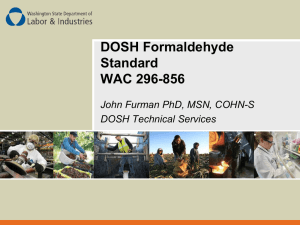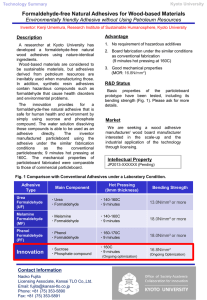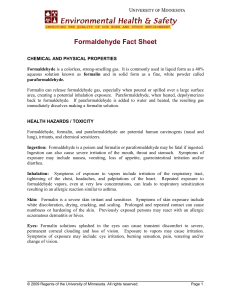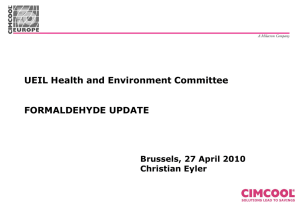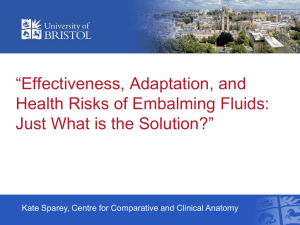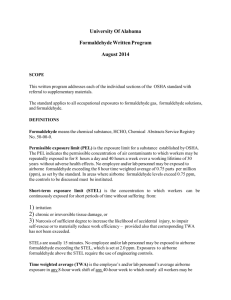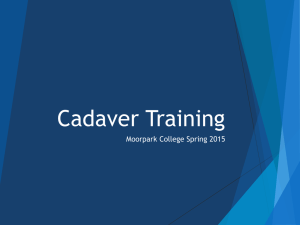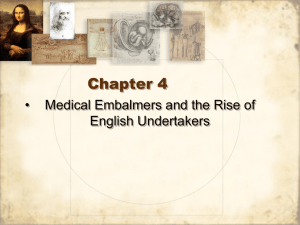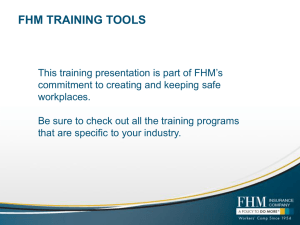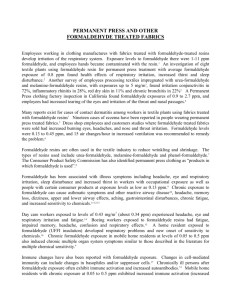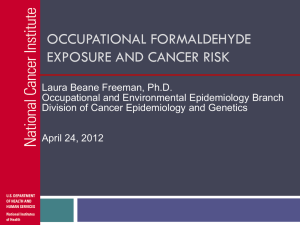Click here to Presentation
advertisement
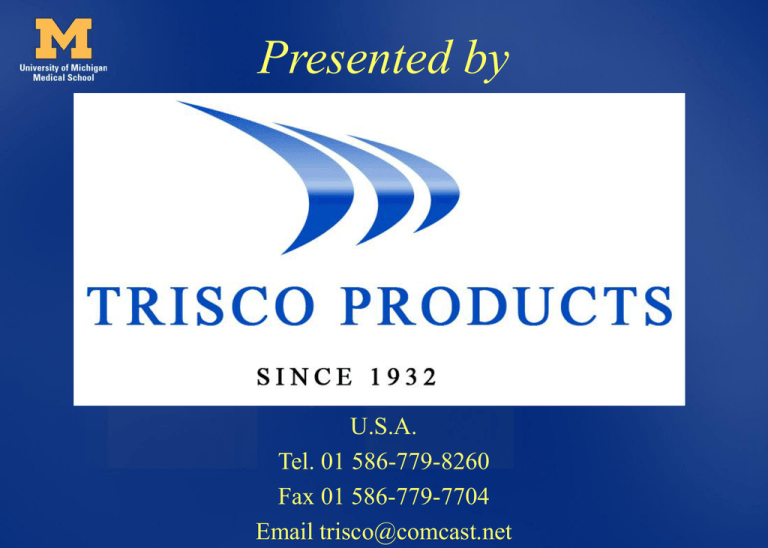
Presented by U.S.A. Tel. 01 586-779-8260 Fax 01 586-779-7704 Email trisco@comcast.net Formaldehyde Neutralization in the Embalming Laboratory W.E. Burkel , D.A. Mueller, and T.R. Gest Division of Anatomical Sciences University of Michigan Medical School TO: William Burkel, Professor Anatomy and Cell Biology 5713 Medical Science Building II 0616 FROM: Ed Valentine, Industrial Hygienist DATE: September 29, 1994 SUBJECT: Formaldebyde Sampling, Gross Anatomy Laboratory, Medical Science Building II On September 16, 1994, samples of airborne formaldehyde were collected during a gross anatomy laboratory session in rooms 3635, 3637, 3613, and 3605 of the Medical Science Building II. During sampling, students and instructors dissected the neck region of cadavers fixed with an embalming solution containing formaldehyde, glutaraldehyde, and ethanol. Samples were collected on Assay Technology passive dosimeters and were analyzed at an American Industrial Hygiene Association accredited laboratory. All samples were collected in the breathing zone of instructors and students. Four samples were collected for the duration of the lab session and five samples were collected during selected fifteen minute periods throughout the lab session... Federal and state standards for formaldehyde set perrnissible exposure limits at 0.75 ppm for an eight hour time-weighted average exposure (TWA) and 2 ppm for a fifteen minute short term exposure limit (STEL). The results given in table one indicate that employees have been exposed above these limits. TWA results ranged from 0.29 to 1.15 ppm. The STEL results ranged from 1.2 to 4.1 ppm. The eight hour TWAs were calculated with the assumption that employees were not exposed to formaldehyde outside of the saunpled period. Engineering and/or administrative controls must be put into place to reduce formaldehyde exposure in the gross anatomy classes. The attached summary of the formaldehyde standard outlines the procedures that must be put into place at various exposure levels. The ventilation system must be checked for proper operation. If the system is operating correctly, and other means of exposure reduction cannot be implemented, modification of the ventilation system should be investigated through Facilities Planning and Design.... TWA Before Engineering Controls--ppm TWA=breathing zone exposure averaged over 8 hours Permissible limit 0.75 ppm 1.15 0.94 0.48 0.29 0.44 0.21 0.72 0.07 0.43 0.63 0.30 0.79 Average 0.60 STDEV 0.41 Range 0.21-1.80 0.35 0.53 1.80 0.63 0.49 TWA - AFTER Engineering Controls - ppm TWA=breathing zone exposure averaged over 8 hours Permissible limit 0.75 ppm 0.37 0.37 0.29 0.32 0.45 0.23 0.49 0.68 0.35 0.40 0.30 0.38 Average 0.35 STDEV 0.14 Range 0.11-0.68 0.32 0.19 0.14 0.11 0.54 STEL Before Engineering Controls STEL= Short term (15 min.) Exposure in breathing zone Permissible STEL = 2.0 ppm Average STDEV Range 2.07 1.08 1.2-6.5 2.70 1.90 4.10 1.20 3.10 1.60 1.60 1.30 1.80 1.30 3.00 1.30 1.50 1.60 1.30 6.50 2.10 3.00 STEL AFTER Engineering Controls STEL= Short term (15 min.) Exposure in breathing zone Permissible STEL = 2.0 ppm Average STDEV Range 1.63 1.02 0.45-3.4 2.30 0.45 1.08 3.00 1.30 0.97 2.60 2.10 1.20 0.40 0.90 0.60 0.50 3.40 TIME WEIGHTED ANALYSIS TWA Time Weighted (8hr ave.) Analysis -TWA 0.6 0.5 0.4 ppm ppm 0.3 0.2 0.1 0 1 2 BEFORE AFTER ENGINEERING ENGINEERING CONTROLS CONTROLS 3 4 AFTER AFTER INFUTRACE MEA SHORT TERM EXPOSTURE LIMIT SHORT TERM (15 min.) EXPOSURE LIMIT--STEL 2.5 2 1.5 ppm 1 0.5 0 1 2 BEFORE AFTER ENGINEERING ENGINEERING CONTROLS CONTROLS 3 4 AFTER AFTER INFUTRACE MEA Date: Thu, 11 Dec 97 11:38:52 EST From: Janet Follo <follo@umich.edu> To: wburkel@umich.edu Subject: Formaldehyde Test Results Dr. Burkel Great News! I finally received the last of the formaldehyde results for the monitoring we did back in November with monoethanolamine. All results came back with non-detectable levels of formaldehyde. .... TO: William Burkel, Ph.D., Professor of Anatomy Horace Bomar, Director of Medical Facilities FROM: Janet Follo, OSEH Representative DATE: September 15, 1999 SUBJECT:Formaldehyde Exposure, Gross Anatomy Lab MS II On August 23, 1999 OSEH conducted air sampling for formaldehyde during a gross anatomy laboratory session in rooms 3605, 3613, 3635, and 3637 of the Medical Science Building II Sampling Results The results of this sampling survey indicated that TWA ranged from 0.09 ppm to 0.22 ppm, all below the PEL. The STEL results ranged from 0.30 ppm to 0.81 ppm, all below the STEL. Conclusions and Follow up The measured formaldehyde exposures for this survey are considered safe, in comparison to current criteria. The University has met the safety criteria of the Formaldehyde Standard and is currently exempt from major parts of the regulation. This includes air monitoring and medical surveillance requirements. Additional monitoring and or medical surveillance may be warranted if changes in the preparation of cadavers occur. Embalming: • Place Cadaver on embalming blocks to allow drainage • Disinfect body, shave hair • Identify cadaver in more than one location Place Cadaver on embalming blocks to allow drainage Disinfect Cadaver with Tris Spray Identify cadaver in Two or more Spots Identify Cadaver in more than one Location •Embalming •Simple Instruments •Aneurism Hooks, Large Bent Forceps, Scissors, Injection canula Embalming (continued): • Raise right common carotid and place injection canula • Raise right jugular vein and place long bent forceps into right atrium • Mix embalming chemical • Raise Right Common Carotid and place injection canula • Raise Right Jugular Vein and place long bent forceps into right atrium and right ventricle Stock Embalming Chemical Formaldehyde (37%) 2.50 % Ethanol 13.53 % Non-Ionic Detergent 0.12 % EDTA 0.4 % Ethylene Glycol 3.38 % Gluteraldehyde 1.08 % Methanol 0.47 % Embalming Solution: Embalming Chemical - 23% Deionized Water - 77% •First Injection •Inject Embalming Chemical at 20 pounds of pressure •Inject a 3.5 gallon solution •Wait 24 hours •Second Injection •Same solution as first injection •Wait 24 hours •Third Injection •Same solution as second injection except •Wait 48 hours •Neutralization Injection •10 quarts deionized water •Add 16 oz. of Trisco Formaldehyde Neutralizer •Inject chemical at 20 pounds pressure •Wait 24 hours •Remove instruments •Mist Cadaver with Tris Spray •Place in 5 mil plastic bag and seal shut Cost of Neutralization Trisco Formaldehyde Neutralizer - $2.25 per cadaver Infutrace - approximately $12.00 per cadaver Benefits of Trisco Formaldehyde Neutralizer •No Formaldehyde exposure •No downdraft tables and equipment needed •No crystals •Low cost •Simple solution to formaldehyde problems •OSEH will love you Actual specimens embalmed and neutralized using the procedures described in this program Actual specimens embalmed and neutralized using the procedures described in this program Actual specimens embalmed and neutralized using the procedures described in this program Presented by U.S.A. Tel. 01 586-779-8260 Fax 01 586-779-7704 Email trisco@comcast.net
